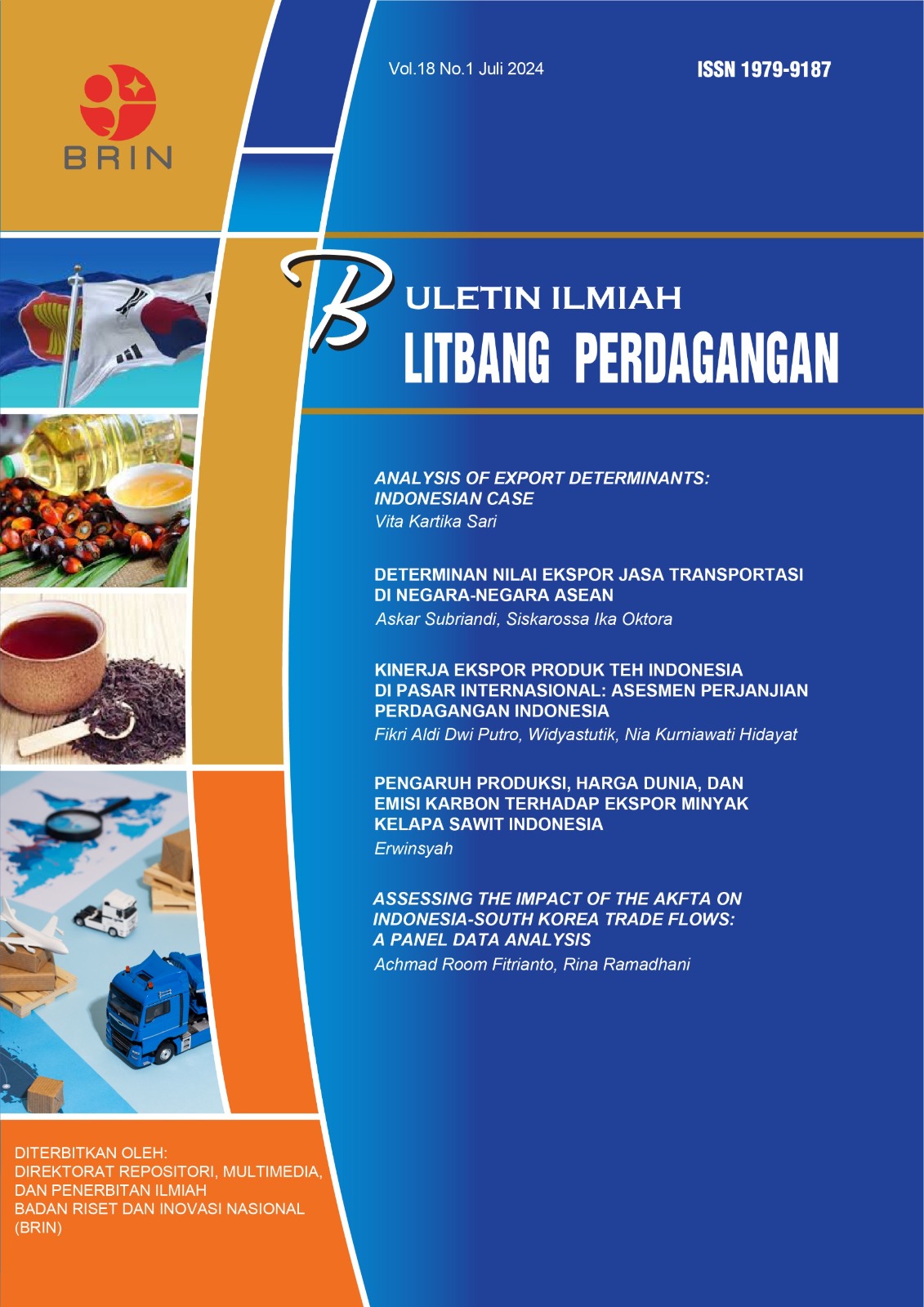Kinerja Ekspor Produk Teh Indonesia di Pasar Internasional: Asesmen Perjanjian Perdagangan Indonesia
DOI:
https://doi.org/10.55981/bilp.2024.3632Keywords:
export expansion, PPML, tea export, trade barriers, trade agreements utilizationAbstract
The decline in Indonesian tea products export performance does not correspond to the Government initiatives to reduce barriers through trade agreements. This research aims to analyse the export performance and the role of trade agreements towards Indonesian tea products export. This study employs panel data regression with a 15-year time series (2007-2021) and a cross-section of 40 destination countries. The data are analysed using a modified export approach gravity model with Poisson Pseudo-Maximum Likelihood (PPML) estimation. The research results show that the Indonesian tea products export destinations are dominated by Asia (19 countries) and Europe (12 countries). The regression results suggest that the implementation of trade agreements with Asian and European region countries has not effectively increased Indonesian tea products export. On the other hand, the implementation of trade agreements with other region countries, i.e., Australia and New Zealand, has successfully promoted export towards Indonesian tea products. Those can be attributed to trade agreements underutilization and trade barriers imposed by the trade agreement members. Hence, inward and outward-looking strategies are necessary to promote the export creation effect of implemented trade agreements towards Indonesian tea product exports.
Downloads
References
Abafita, J., & Tadesse, T. (2021). Determinants of global coffee trade: Do RTAs matter? Gravity model analysis. Cogent Economics & Finance, Vol. 9(1), pp. 1892925. https://doi.org/10.1080/ 23322039.2021.1892925.
Abbass, K., Begum, H., Alam, A.S.A.F., Awang, A.H., Abdelsalam, M.K., Egdair, I.M.M., & Wahid, R. (2022). Fresh insight through a Keynesian theory approach to investigate the economic impact of the COVID-19 pandemic in Pakistan. Sustainability, Vol. 14(3), pp. 1054. https://doi.org/10.3390/su14031054.
Akman, E. (2016). The facilitating role of visa policies on international trade and foreign direct investment. Turkish Studies, Vol. 17(4), pp. 712–732. http://doi.org/10.1080/14683849.2016.1232589.
Ali, N. (2023). Analisis daya saing dan faktor yang mempengaruhi ekspor teh Indonesia di delapan negara Asean. Jurnal Manajemen Akuntansi, Vol. 3(4), pp. 2002–2012. https://doi.org/10.36987/jumsi.v3i4.4736.
Ardiyanti, S.T. (2015). Dampak perjanjian perdagangan Indonesia-Jepang (IJEPA) terhadap kinerja perdagangan bilateral. Buletin Ilmiah Litbang Perdagangan, Vol. 9(2), pp. 129–152. https://doi.org/10.30908/bilp.v9i2.5.
Baier, S.L., & Bergstrand, J.H. (2007). Do free trade agreements actually increase members' international trade?. Journal of International Economics, Vol. 71, pp. 72–95. https://doi.org/10.1016/j.jinteco.2006.02.005.
Bemelmans, J., Curzi, D., Olper, A., & Maertens, M. (2023). Trade effects of voluntary sustainability standards in tropical commodity sectors. Food Policy, Vol. 118, pp. 102440. https://doi.org/10.1016/j.foodpol.2023.102440.
Burger, M., van Oort, F., Linders, G.J. (2009). On the specification of the gravity model of trade: Zeros, excess zeros and zero-inflated estimation. Spatial Economic Analysis, Vol. 4(2), pp. 167–190. https://doi.org/10.1080/17421770902834327.
Czarniecka-Skubina, E., Korzeniowska-Ginter, R., Pielak, M., Sałek, P., Owczarek, T., & Kozak, A. (2022). Consumer choices and habits related to tea consumption by Poles. Foods, Vol. 11(18), pp. 2873. https://doi.org/ 10.3390/foods11182873.
Ditjenbun. (2020). Statistik Perkebunan Unggulan Nasional 2019–2021. Jakarta: Direktorat Jenderal Perkebunan.
Ditjenbun. (2022). Statistik Perkebunan Unggulan Nasional 2021–2023. Jakarta: Direktorat Jenderal Perkebunan.
Egger, P.H., Larch, M., & Yotov, Y.V. (2022). Gravity estimations with interval data: Revisiting the impact of free trade agreements. Economica, Vol. 89, pp. 44–61. https://doi.org/10.1111/ecca.12394.
Eichengreen, B., & Irwin, D.A. (1998). The role of history in bilateral trade flows. Di dalam: Frankel, J.A. (editor). The Regionalization of The World Economy. Chicago: University of Chicago Press. pp. 33–62.
Fugazza, M. (2013). The economics behind non-tariff measures: Theoretical insights and empirical evidence. Policy Issues in International Trade and Commodities Study Series No. 57. Geneva: UNCTAD.
FTA Center. (2023). Free Trade Agreement. Diakses tanggal 5 Mei 2023 dari https://ftacenter.kemendag.go.id/free-trade-agreement.
Gujarati, D.N., & Porter, D.C. (2009). Basics Econometrics. 5th Ed. New York: McGraw-Hill/Irwin.
Gupta, V., Sajnani, M., Dixit, S.K., & Khanna, K. (2022). Foreign tourist's tea preferences and relevance to destination attraction in India. Tourism Recreation Research. Vol. 47(4), pp. 428–442. http://doi.org/10.1080/02508281.2020.1841376.
Handoyo, R., Sugiharti, L., & Esquivias, M. (2021). Trade creation and trade diversion effects: The case of the ASEAN plus six free trade area. Buletin Ekonomi Moneter dan Perbankan, Vol. 24(1), pp. 93–118. https://doi.org/10.21098/bemp.v24i1.1163.
Hotsawadi, & Widyastutik. (2020). Diversifikasi ekspor non migas Indonesia ke pasar non tradisional. Buletin Ilmiah Litbang Perdagangan, Vol. 14(2), pp. 215–238. https://doi.org/10.30908/bilp.v14i2.442.
Hwang, C.W., & Lim, S.S. (2017). Effect of non-tariff measures on international tea trades. Journal of Korea Trade, Vol. 21(4), pp. 309–323. https://doi.org/10.1108/JKT-05-2017-0054.
Iqbal, M., Rabbani, A., Haq, F., & Bhimani, S. (2022). The floods of 2022: Economic and health crisis hits Pakistan. Annals of Medicine and Surgery, Vol. 84, pp. 104800. https://doi.org/10.1016/j.amsu.2022.104800.
Irshad, M.S., Xin, Q., Hui, Z., & Arshad, H. (2018). An empirical analysis of Pakistan’s bilateral trade and trade potential with China: A gravity model approach. Cogent Economics & Finance, Vol. 6(1), pp. 1504409. https://doi.org/10.1080/23322039.2018.1504409.
Ismail, A., Akhtar, S., Riaz, M., Gong, Y.Y., Routledge, M.N., & Naeem, I. (2020). Prevalence and exposure assessment of aflatoxins through black tea consumption in the Multan City of Pakistan and the impact of tea making process on aflatoxins. Frontiers in Microbiology, Vol. 11, pp. 446. https://doi.org/10.3389/fmicb.2020.00446.
ITC MacMap. (2023). Market Access Conditions. Diunduh tanggal 5 Desember 2023 dari https://www.macmap.org.
Jagdambe, S., & Kannan, E. (2020). Effects of ASEAN-India Free Trade Agreement on agricultural trade: The gravity model approach. World Development Perspectives, Vol. 19, pp. 100212. https://doi.org/10.1016/j.wdp.2020.100212.
Jawad, M., & Naz, M. (2023). Impact of Covid-19 pandemic on macroeconomic aspects. Journal of Open Innovation: Technology, Market, and Complexity, Vol. 9, pp. 100126. https://doi.org/10.1016/j.joitmc.2023.100126.
Jomit, C.P. (2014). Export potential of environmental goods in India: A gravity model analysis. Transnational Corporations Review, Vol. 6(2), pp. 115–131. https://doi.org/10.1080/19186444.2014.11658386.
Kemensetneg RI. 2021. Peraturan Pemerintah Republik Indonesia Nomor 26 Tahun 2021 Tentang Penyelenggaraan Bidang Pertanian. Jakarta: Kemensetneg RI.
Khaliqi, M., Gurning, H.R.H, Novanda, R.R., & Simamora, O.N. (2020). Competitiveness Indonesia tea in international market. IOP Conf. Series: Earth and Environmental Science, Vol. 454, pp. 012039. https://doi.org/10.1088/1755-1315/454/1/012039.
Kinzius, L., Sandkamp, A., & Yalcin, E. (2019). Trade protection and the role of non-tariff barriers. Review of World Economics, Vol. 155, pp. 603–643. https://doi.org/10.1007/s10290-019-00341-6.
Krugman, P.R., Obstfeld, M., & Melitz, M.J. (2015). International Economics: Theory and Policy. 10th Ed. (Global Edition). Harlow: Pearson Education Limited.
Lateef, M., Tong, G.J., & Riaz, M.U. (2018). Exploring the gravity of agricultural trade in China–Pakistan free trade agreement. The Chinese Economy, Vol. 51(6), pp. 522–533. https://doi.org/10.1080/10971475.2018.1481008.
Lohani, K.K. (2020). Trade flow of India with BRICS countries: A gravity model approach. Global Business Review, OnlineFirst, pp. 1–18. https://doi.org/10.1177/0972150920927684.
Mashayekhi, M. (2020). Services trade, structural transformation and the SDG 2030 agenda. Di dalam: Klasen, A. (editor). The Handbook of Global Trade Policy. Hoboken: John Wiley & Sons Ltd. pp. 79–117.
Mayer, T., & Zignago, S. (2011). Notes on CEPII’s distances measures: The GeoDist database. CEPII Working Paper No. 2011-25. Paris: CEPII.
Naabi, A.A., & Bose, S. (2020). Do regulatory measures necessarily affect Oman’s seafood export-supply?. SAGE Open, Vol. 10(3), pp. 1–16. https://doi.org/10.1177/2158244020950658.
Nagoor, B.H., & Kumar, C.N. (2010). Assessing the impact of the ASEAN-India FTA on the tea industry. Economic and Political Weekly, Vol. 45(44/45), pp. 112–116. http://www.jstor.org/stable/20787537.
Nair, K.P. (2021). Tree Crops: Harvesting Cash from the World’s Important Cash Crops. Cham: Springer.
Ningsih, E.A., Falianty, T.A., & Budiarti, F.T. (2018). Pemanfaatan kerja sama Indonesia-Jepang economic partnership agreement (IJEPA) dan Indonesia-Pakistan preferential trade agreement (IPPTA). Buletin Ilmiah Litbang Perdagangan, Vol. 12(2), pp. 181–204. https://doi.org/10.30908/bilp.v12i2.313.
Nursodik, H., Santoso, S.I., & Nurfadillah, S. (2021). Competitiveness and determining factors of Indonesian tea export volume in the world market. Habitat, Vol. 32(3), pp. 163–172. https://doi.org/10.21776/ub.habitat.2021.032.3.18.
Octaviani, A. (2018). Pengaruh integrasi ekonomi Asean & non Asean terhadap ekspor komoditi karet Indonesia: trade creation atau trade diversion. Economics Development Analysis Journal, Vol. 7(1), pp. 14–22. https://doi.org/10.15294/edaj.v7i1.21919.
Okabe, M., & Urata, S. (2014). The impact of AFTA on intra-AFTA trade. Journal of Asian Economics, Vol. 35, pp. 12–31. https://doi.org/10.1016/j.asieco.2014.09.004.
Olayungbo, D.O., & Iqbal, B.A. (2021). An empirical analysis of African trade blocs effects on the global economy: New evidence from the gravity model. Future Business Journal, Vol. 7, pp. 45. https://doi.org/10.1186/s43093-021-00089-2.
Paul, T., & Mondal, S. (2019). A strategic analysis of tea leaves supply chain before manufacturing – a case in Assam. Benchmarking: An International Journal, Vol. 26(1), pp. 246–270. https://doi.org/10.1108/BIJ-01-2018-0007.
Ramaswamy, S., Choutagunta, A., & Sahu, S.K. (2021). Evaluating Asian free trade agreements: What does gravity model tell us?. Foreign Trade Review, Vol. 56(1), pp. 60–70. https://doi.org/10.1177/0015732520961330.
Salvatore, D. (2014). Ekonomi Internasional. Ed. ke-9. Buku 1. Hartanto, R.B., Prakoso, Y.H. (penerjemah). Jakarta: Penerbit Salemba Empat.
Santeramo, F.G., Guerrieri, V., & Lamonaca, E. (2019). On the evolution of trade and sanitary and phytosanitary standards: The role of trade agreements. Agriculture, Vol. 9(1), pp. 2. https://doi.org/10.3390/agriculture9010002.
Santos Silva, J.M.C., & Tenreyro, S. (2006). The log of gravity. The Review of Economics and Statistics, Vol. 88(4), pp. 641–658. https://doi.org/10.1162/rest.88.4.641.
Shahriar, S., Qian, L., & Kea, S. (2019). Determinants of exports in China’s meat industry: A gravity model analysis. Emerging Markets Finance and Trade, Vol. 55(11), pp. 2544–2565. https://doi.org/10.1080/1540496X.2019.1578647.
Shariasih, E. (2016). Khazanah Arsip Perkebunan Teh Priangan. Jakarta: Arsip Nasional Republik Indonesia.
Singh, L.B. (2021). Impact of India-ASEAN free trade agreement: An assessment from the trade creation and trade diversion effects. Foreign Trade Review, Vol. 56(4), pp. 400–414. https://doi.org/10.1177/00157325211021503.
Sita, K., & Rohdiana, D. (2021). Analisis kinerja dan prospek komoditas teh. RADAR: Opini dan Analisis Perkebunan, Vol. 2(1), pp. 2–12.
Sitepu, E.M.P., & Nurhidayat, R. (2015). Mengukur tingkat pemanfaatan FTA yang telah dilakukan Indonesia: Studi kasus dengan menggunakan FTA preference indicator. Kajian Ekonomi dan Keuangan, Vol. 19(3), pp. 284–298. https://doi.org/10.31685/kek.v19i3.147.
Suhardoyo, F.A., Syafrial, S., & Muhaimin, A.W. (2016). Dampak kebijakan pajak pertambahan nilai terhadap kinerja ekonomi kopi di Indonesia. Habitat, Vol. 27(3), pp. 109–121. https://doi.org/10.21776/ub.habitat.2016.027.3.13.
Takako, M. (2018). Tea drinking culture in Russia. Journal of International Economic Studies, Vol. 35, pp. 57–74. http://doi.org/10.15002/00014558.
Takano, R., & Kanama, D. (2019). The growth of the Japanese black tea market: How technological innovation affects the development of a new market. Journal of Economic Structures, Vol. 8(13), pp. 1–13. http://doi.org/10.1186/s40008-019-0143-5.
Taneja, N., Ray, R., Dayal, I., & Bimal, S. (2017). Emerging issues in India–Pakistan trade: An introduction. Di dalam: Taneja, N., Dayal, I. (editor). India-Pakistan Trade Normalisation: The Unfinished Economic Agenda. Singapore: Springer. pp. 1–14.
Tanuputri, M.R., Bai, H. (2022). Analysis of logistics cost on smallholder and middleman to foster tea supply chain: A case study in Central Java Province, Indonesia. AgriTECH, Vol. 42(2), pp. 155–164. https://doi.org/10.22146/agritech.63671.
Timsina, K.P., & Culas, R.J. (2020). Impacts of Australia’s free trade agreements on trade in agricultural products: An aggregative and disaggregative analysis. The Australian Journal of Agricultural and Resource Economics, Vol. 64, pp. 889–919. https://doi.org/10.1111/1467-8489.12377.
TRAINS UNCTAD. (2023). TRAINS NTM Database. Diunduh tanggal 5 Desember 2023 dari https://trainsonline.unctad.org/home.
UN Comtrade. (2023). UN Comtrade Statistic Database-Data Query of Import and Export. Diunduh tanggal 5 Mei 2023 dari https://comtrade.un.org/data.
van Bergeijk, P.A.G., & Brakman, S. (2010). The Gravity Model in International Trade: Advances and Applications. Cambridge: Cambridge University Press.
Washington Post. (2022, 16 Juni). Pakistan Urges Citizens to Give Up Tea to Help Economy. Diakses tanggal 13 Februari 2024 dari https://www.washingtonpost.com/world/2022/06/16/pakistan-economy-tea-currency-reserves-imports/.
Widyastuti, I.B., Yudono, P., & Putra, E.T.S. (2021). Pengaruh media pada karakter biokimia dan keberhasilan pencangkokan panaman teh (Camellia sinensis L. (O.) Kuntze) pada klon TRI2025. Jurnal Ilmu Pertanian Indonesia, Vol. 26(1), pp. 113–119. https://doi.org/10.18343/jipi.26.1.113.
Wood, J., Wu, J., Li, Y., & Kim, J. (2019). The impact of TBT and SPS measures on Japanese and Korean exports to China. Sustainability, Vol. 11(21), pp. 6141. https://doi.org/10.3390/su11216141.
Yang, S., & Martinez-Zarzoso, I. (2014). A panel data analysis of trade creation and trade diversion effects: The case of ASEAN–China free trade area. China Economic Review, Vol. 29, pp. 138–151. http://doi.org/10.1016/j.chieco.2014.04.002.
Zuhdi, F., Rambe, K.R., & Rahmadona, L. (2022). Analysis of competitiveness and forecasting of Indonesian tea exports to main destination countries. Media Ekonomi dan Manajemen, Vol. 37(2), pp. 240–251. https://doi.org/10.24856/mem.v37i2.2888.
Downloads
Published
How to Cite
Issue
Section
License
Copyright (c) 2024 Fikri Aldi Dwi Putro, Widyastutik, Nia Kurniawati Hidayat

This work is licensed under a Creative Commons Attribution-ShareAlike 4.0 International License.




 Buletin Ilmiah Litbang Perdagangan
Buletin Ilmiah Litbang Perdagangan